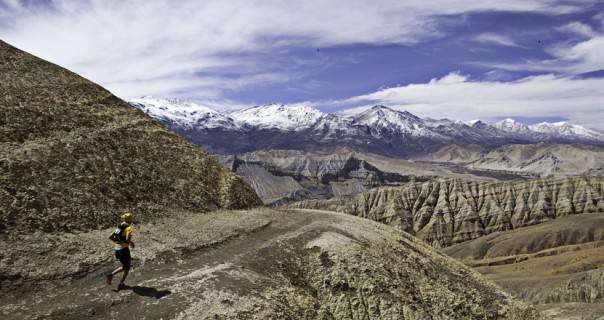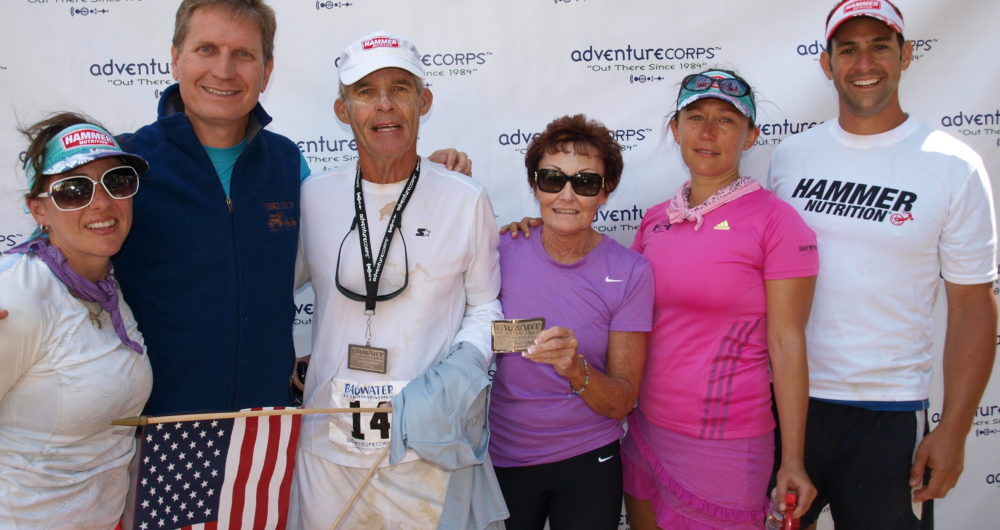1. Physical Training
I run 120-miles a week for three months. Half the mileage is on the flats and half in the hills. I do daily core strengthening and stretching workouts at a fitness center and cross-train with long bike rides. This stamina and confidence boosting training regimen may seem extreme, but so is Badwater or any ultra race.
2. Sauna Training*
After my daily mileage I bake in a 170-degree sauna for up to an hour. The sauna enhances performance by acclimating the body to the extreme 130-degree blast furnace-like desert heat (in cooler ultras it helps ratchet up the comfort level when dealing with our internal heating system) and also prepares the system to process (absorbing and sweating) the large quantities of liquids consumed during the race. This may be the most important tip.
*See the various sauna and heat training articles in the Training & Preparation section at in the Badwater University section here at Badwater.com, especially Arthur’s own article, “Heat Training in a Sauna.”
3. Skin Protection and Cooling*
The sun’s intense heat, the drying winds, and the 200-degree pavement sap exposed body parts – especially the back, hamstrings, quadriceps and calf muscle groups – and your performance will really suffer.
I cover myself with a long sleeved Patagonia white shirt and matching pants, a shrouded hat and sun screen. When it is really hot my crew will soak me with cold water from a garden type sprayer or drape my shoulders with a cold water soaked towel. I carry an 8-ounce spritzer of ice water. The mist I spray on my face and other hot spots is a refreshing coolant.
*See the various “Foot Care and Skin Care” articles in the Training & Preparation section in the Badwater University section here at Badwater.com
4. Feet and Blisters*
Shoes: I usually wear my most comfy shoe the first day and change to another pair with the toe box cut out the second day. I have worn flip-flops for several miles for even more relief.
Socks: I prefer a light cotton sock filled with Gold Bond foot powder but this year I will try the highly touted Injinji wicking toe sock.
Blisters: Against conventional wisdom, I never tape my feet. For the ugly blistering (that will never stop me), it’s simply cut, drain and go. Besides, they all heal in a few weeks.
*See the various “Foot Care and Skin Care” articles in the Training & Preparation section in the Badwater University section here at Badwater.com
5. “Speed Kills”
Since I am not an elite runner (though they can also crash) my mantra is to run the easy parts easy and power walk the hard parts. This is a difficult proposition, especially as you watch other runners disappear into the horizon, but it is effective. My two best times were a direct result of sticking to this discipline.
6. Support Van Supplies
Contains a large chest filled with dry ice, cubes and blocks (dry ice on the bottom of the chest helps slow down the melting process of the regular ice). The cubes and blocks are used to top off four smaller chests containing liquids of choice and two five-gallon coolers of water for drinking and spraying. If overheated, I will climb inside the large cooler to cool off. Sizzle!
7. Rest Stops
If one paces properly, a ten minute or less respite at the time stations is more than sufficient. Use the time to change shoes, socks, clothing, gorge on liquids and electrolytes and possibly take a short cooling dip in the pool at Furnace Creek, Stovepipe Wells and Lone Pine. Then get going.
8. Beware of the Chair
It is comfy to sit in a chair for long periods, but more than a few minutes is counter-productive. Based on experience I know that lots of time, which can easily amount to hours is wasted (attempting to recover, socializing, eating, etc.) at the check-in stations.
Skip the chair. It takes too many miles to get the body fluid and back up to speed again. It is more advantageous to continue to move forward at a more relaxed pace (amazingly, the body seems to recover faster on the move).
9. “Shortening” the Race Route
I had a tendency to run Badwater from time station to time station, but they are about 20-miles apart. Long desolate and arid stretches of desert in 120/130-degree temperatures was hard to mentally grapple with. Whew! There is nothing worse than concentrating on a time station that is ten-miles in the distance and never seems to get closer.
To chop up the Badwater course into shorter and mentally comforting running zones, I began concentrating on the landmark and other signage that are three to four-miles apart. If I want to shorten the course even more (especially during the second day when I get extremely tired) I use the mile-marked posts or the alternately (on the other side of the highway) marked one half mile posts. Yes, it really, really helps!
10. Music
At times, music soothes the soul and at times it is distracting. Still, a useful tool; wherever I go, my iPod goes.
11. Nutrition
The body can only process about 350-calories an hour. I drink one cold Ensure Plus every hour and an occasional Power Gel or GU. At times Sustained Energy, Perpetuem, peanut butter, soup or turkey slices are used to provide a good change of pace. Liquid meals are best in extreme conditions, because they are digested quickly and the blood used in the process is able to return to the extremities to help cool the body surface.
12. Electrolytes*
To help prevent cramping and dehydration I will take Endurolytes or S!Caps. They contain the proper mix of potassium, sodium and magnesium. In extreme heat I will take the recommended dosage (experiment during training runs). Previously, salt replacement was guesswork and I had incredible cramping episodes. I started using these products at Badwater after about five years and the cramping has stopped. They work.
13. Hydration*
Every few miles I drink 16-ounces of cold Crystal Geyser water, PowerAde or a Starbucks Frappuccino (my preferred drinks). The body can only process about 32-ounces of liquids an hour (maybe a bit more in extreme temperatures, but not much more!) so it is important not to over-hydrate.
To eliminate the water loss or gain guesswork we frequently check my weight using an electronic scale. Your weight the day before the race is a good baseline. Be careful: Starting line weight can be misleading because most runners are already a tad over-hydrated. A constant weight or a few pounds either way is preferred; any more leads to the troubles below.
The following five points are hydration and electrolyte problems (Karl King, Ultrarunning Magazine, 2007) that I have personally experienced. Yuck! Beware! Medical assistance may be required to correct any of these conditions. Finishing the race is probable, but you will be red-lining in the danger zone.
A) Low on Fluids and Possibly Electrolytes
Symptoms: Plunging weight, lightheaded, shortness of breath, stop and go slower and wobbly pace, urine is yellow and sparse. Hint: Severe dehydration; the worst case scenario.
Solution: Consume liquids immediately. Further deterioration leads to dizzy spells, rust colored urine, fainting and hours of down time, which could lead to the ugly DNF; and will if an IV is used.
*** Immediate indication of dehydration: Squeeze all your toes together for five seconds. If they spring back you are OK. If they stay curled or curl up more you are dehydrating and need to remedy ASAP.
B) Low on Electrolytes but Fluids are OK
Symptoms: Horrible cramping begins. Wham! They strike incredibly fast and are generally severe. You wind up on the ground curled up like a pretzel. Weight, urine output and color had been okay? Hint: You need electrolytes.
Solution: Immediately start replacing with S!Caps, Endurolytes, salt tablets, etc. Don’t lay there. Get up and start moving at an easy pace. In less than an hour the sodium level will balance and the cramping will subside. Yeah!
C) Too Much Water and Electrolytes are OK
Symptoms: The stomach begins to bloat (easy to spot as you begin to look pregnant) and urine output is normal and clear. Weight is up a few pounds and you feel a bit sluggish. Oops, I have gone to the starting line in this condition!
Solution: Correct this very common over-hydration condition by drinking less (until weight is normal). Drinking more fluids may lead to the next problem.
D) Too Much Water and Low Electrolytes
Symptoms: The stomach looks like a water-filled balloon, there if puffiness in your extremities, your weight is way up, and at times there is excessive clear urination. You are sluggish and performance suffers because you have to stop to water the cactus every five minutes. Hint: You are super-hydrated.
Solution: Boost electrolytes and forget the fluids until your weight is normal. This may take several hours or more!
E) Too Much Water and High Electrolytes
Symptoms: You look and feel like the Pillsbury doughboy. Weight is much too high, the stomach is bloated and all the extremities are really swollen. Urine output is clear and sparse. You are sluggish and your performance is suffering dramatically. Hint: You are maxed out with water and sodium.
Solution: Stop fluid and electrolyte intake until you’re weight normalizes, which may take hours or days.
14. Pacers
My top three points if a pacer is used:
- “Pace” behind the runner: (Badwater race rule). It’s easier to monitor from behind and it gives the runner a clearer view of any immediate footing or tripping problems on the trail/road.
- No unsolicited chatter: Distracts a tired and focused runner.
- Aid stations: Get your runner in and out quickly. Prod them. Make sure they drink soups, take electrolytes and don’t get comfy sitting down. Remind them that they will feel better if they continue to move forward. “Time waits for no man.”
15. Crewing*
Ten Badwater helpful hints.
- Have several pre-race meetings to cover all the crew responsibilities and contingency plans.
- Crew must take turns sleeping/resting. A major objective is to have fresh people, especially during the second day. Crew should appear energized even if you are not. This keeps the runner positive.
- Leap-frog the runner in two-mile intervals, give or take, depending on the availability of parking spots, the terrain, the heat, and the runner’s condition.
- Attempt to park the support vehicle in the runner’s sight (except on winding mountain passes). A tired runner equates out of sight as not being there or not caring. It is a mental downer and performance really suffers.
- Cater to the runner’s needs on the up-slope of a hill. Runners usually run the down hills; no need to stop their momentum.
- Make sure runner doesn’t stay in a chair or rest stop too long. (Unless medically necessary). Keep them moving forward.
- Use the scale to weigh and chart the runner’s fluid situation; especially when it is extremely hot. Correct imbalances immediately.
- Chart food, liquid and electrolyte intake at preplanned intervals. This should keep the tired runner – who has no ability to remember these details – balanced.
- Understand and follow all other race rules.
- Bonus points for runner and crew: Laugh and have some fun!
16. The Runner
Please, no groveling or whining. Treat your crew (and race staff) with due respect. They deserve tons of thanks for their volunteered time. A tired and pissed off crewmember / pacer will never enhance your effort. Their responsibility is to pamper and prod you through the event. Your responsibility is to stand tall and silently deal with the pain, misery and suffering and to finish the race. Don’t forget you were the one who filled out the race application.
Good luck to all.
Arthur Webb, Badwater 135 Finisher in 98, 99, 00, 01, 02, 04, 05, 06, 07, 08, 09, 10, 11, and 12





